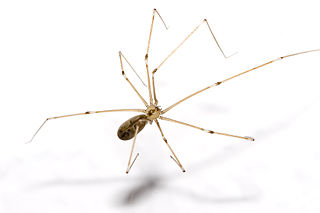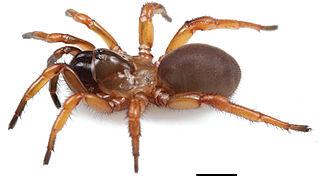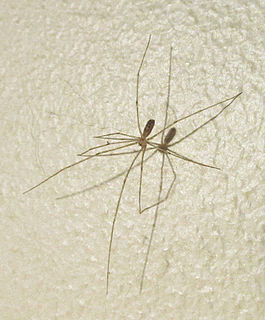
Huntsman spiders, members of the family Sparassidae, are known by this name because of their speed and mode of hunting. They are also called giant crab spiders because of their size and appearance. Larger species sometimes are referred to as wood spiders, because of their preference for woody places. In southern Africa the genus Palystes are known as rain spiders or lizard-eating spiders. Commonly they are confused with baboon spiders from the Mygalomorphae infraorder, which are not closely related.

The Pholcidae are a family of araneomorph spiders. The family contains over 1,800 pholcids, including those commonly known as the marbled cellar spider , daddy long-legs spider, granddaddy long-legs spider, carpenter spider, daddy long-legger, vibrating spider, gyrating spider, long daddy, and skull spider. The family, first described by Carl Ludwig Koch in 1850, is divided into 94 genera.

Marchena is a genus of jumping spiders only found in the United States. Its only described species, M. minuta, dwells on the barks of conifers along the west coast, especially California, Washington and Nevada.

Myrmekiaphila is a genus of North American mygalomorph trapdoor spiders in the family Euctenizidae, and was first described by G. F. Atkinson in 1886. All described species are endemic to the southeastern United States.

Huka is a genus of South Pacific funnel weavers first described by Raymond Robert Forster & C. L. Wilton in 1973.

Agroeca brunnea is a species of spider in the family Liocranidae. It is found in the Palearctic realm and was first described by John Blackwall in 1833.

Agroeca is a genus of liocranid sac spiders that was first described by Niklas Westring in 1861.

Prochora praticola is a species of spider in the family Miturgidae. It is found in China, Korea, and Japan, and was first described by Friedrich Wilhelm Bösenberg and Embrik Strand in 1906 as Agroeca praticola.
Zorodictyna oswaldi is a species of spider in the family Udubidae, found in Madagascar. It was first described in 1891 by Heinrich Lenz as Agroeca oswaldi. The species name honours Albert O'Swald whose collection had been given to Lenz; the name was originally written o'swaldi. In 1908 Embrik Strand placed it in the genus Uliodon; in 1967 Pekka T. Lehtinen transferred it to Zorodictyna.
M. minuta can refer to a few different species. The specific epithet minuta means "minute" or "small".

Psilochorus simoni is a species of cellar spider in the family Pholcidae. It is found in the United States, has been introduced into Europe, Turkey, and New Zealand.
Micaria pasadena is a species of ground spider in the family Gnaphosidae. It is found in the United States and Mexico.
Eulechriops minutus is a species of true weevil in the beetle family Curculionidae. It is found in North America.

Agroeca ornata is a species of liocranid sac spider in the family Liocranidae. It is found in the United States, Canada, and Russia.

Talavera minuta is a species of jumping spider in the family Salticidae. It is found in Russia, Canada, and the United States.
Euphilotes bernardino, the Bernardino blue, is a butterfly in the family Lycaenidae. The species was first described by William Barnes and James Halliday McDunnough in 1916. It is found in North America.
Agroeca trivittata is a species of liocranid sac spider in the family Liocranidae. It is found in the United States.

Agroeca pratensis is a species of liocranid sac spider in the family Liocranidae. It is found in the United States and Canada.
Agroeca proxima is a species of spider belonging to the family Liocranidae.











